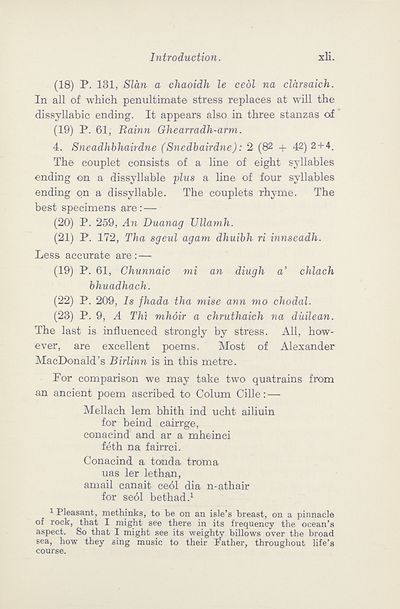Download files
Complete book:
Individual page:
Thumbnail gallery: Grid view | List view

Introduction.
xli.
(18) P. 131, Sian a chaoidh le cedi na clarsaich.
In all of which penultimate stress replaces at will the
dissyllabic ending. It appears also in three stanzas of
(19) P. 61, Rainn Ghearradh-arm.
4. Sneadhbhairdne (Snedbairdne): 2 (82 + 42) 2 + 4.
The couplet consists of a line of eight syllables
ending on a dissyllable plus a line of four syllables
ending on a dissyllable. The couplets rhyme. The
best specimens are:^—
(20) P. 259, An Duanag Ullamh.
(21) P. 172, Tha sgeul agam dhuibh ri innseadh.
Less accurate are:—
(19) P. 61, Chunnaic mi an diugh a’ chlach
bhuadhach.
(22) P. 209, Is fhada tha mise ann mo chodal.
(23) P. 9, A Thi mhoir a chruthaich na diiilean.
The last is influenced strongly by stress. All, how¬
ever, are excellent poems. Most of Alexander
MacDonald’s Birlinn is in this metre.
For comparison we may take two quatrains from
an ancient poem ascribed to Colum Cille: —
Mellach lem bhith ind ucht ailiuin
for beind cairrge,
conacind and ar a mheinci
feth na fairrci.
Conacind a tonda troma
uas ler lethan,
amail canait ce61 dia n-athair
for sedl bethad.1
1 Pleasant, methinks, to be on an isle’s breast, on a pinnacle
of rock, that I might see there in its frequency the ocean’s
aspect. So that I might see its weighty billows over the broad
sea, how they sing music to their Father, throughout life’s
course.
xli.
(18) P. 131, Sian a chaoidh le cedi na clarsaich.
In all of which penultimate stress replaces at will the
dissyllabic ending. It appears also in three stanzas of
(19) P. 61, Rainn Ghearradh-arm.
4. Sneadhbhairdne (Snedbairdne): 2 (82 + 42) 2 + 4.
The couplet consists of a line of eight syllables
ending on a dissyllable plus a line of four syllables
ending on a dissyllable. The couplets rhyme. The
best specimens are:^—
(20) P. 259, An Duanag Ullamh.
(21) P. 172, Tha sgeul agam dhuibh ri innseadh.
Less accurate are:—
(19) P. 61, Chunnaic mi an diugh a’ chlach
bhuadhach.
(22) P. 209, Is fhada tha mise ann mo chodal.
(23) P. 9, A Thi mhoir a chruthaich na diiilean.
The last is influenced strongly by stress. All, how¬
ever, are excellent poems. Most of Alexander
MacDonald’s Birlinn is in this metre.
For comparison we may take two quatrains from
an ancient poem ascribed to Colum Cille: —
Mellach lem bhith ind ucht ailiuin
for beind cairrge,
conacind and ar a mheinci
feth na fairrci.
Conacind a tonda troma
uas ler lethan,
amail canait ce61 dia n-athair
for sedl bethad.1
1 Pleasant, methinks, to be on an isle’s breast, on a pinnacle
of rock, that I might see there in its frequency the ocean’s
aspect. So that I might see its weighty billows over the broad
sea, how they sing music to their Father, throughout life’s
course.
Set display mode to:
![]() Universal Viewer |
Universal Viewer | ![]() Mirador |
Large image | Transcription
Mirador |
Large image | Transcription
| An Comunn Gàidhealach > An Comunn Gàidhealach Publications > Bardachd Ghaidhlig > (45) |
|---|
| Permanent URL | https://digital.nls.uk/126281672 |
|---|
| Description | This contains items published by An Comunn, which are not specifically Mòd-related. It includes journals, annual reports and corporate documents, policy statements, educational resources and published plays and literature. It is arranged alphabetically by title. |
|---|
| Description | A collection of over 400 items published by An Comunn Gàidhealach, the organisation which promotes Gaelic language and culture and organises the Royal National Mòd. Dating from 1891 up to the present day, the collection includes journals and newspapers, annual reports, educational materials, national Mòd programmes, published Mòd literature and music. |
|---|---|
| Additional NLS resources: |
|

